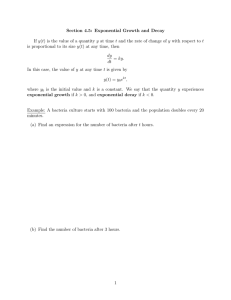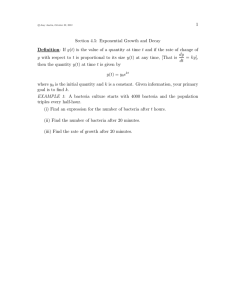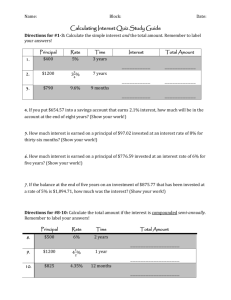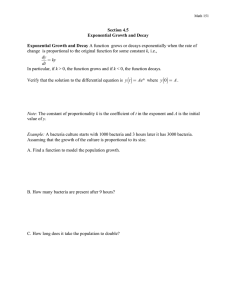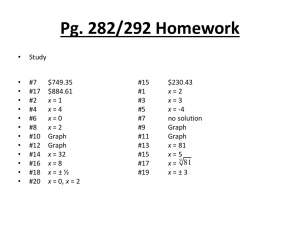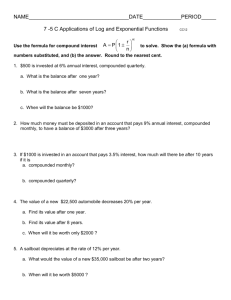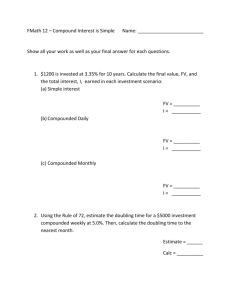MATH 151 Engineering Math I, Spring 2014 JD Kim Week10
advertisement
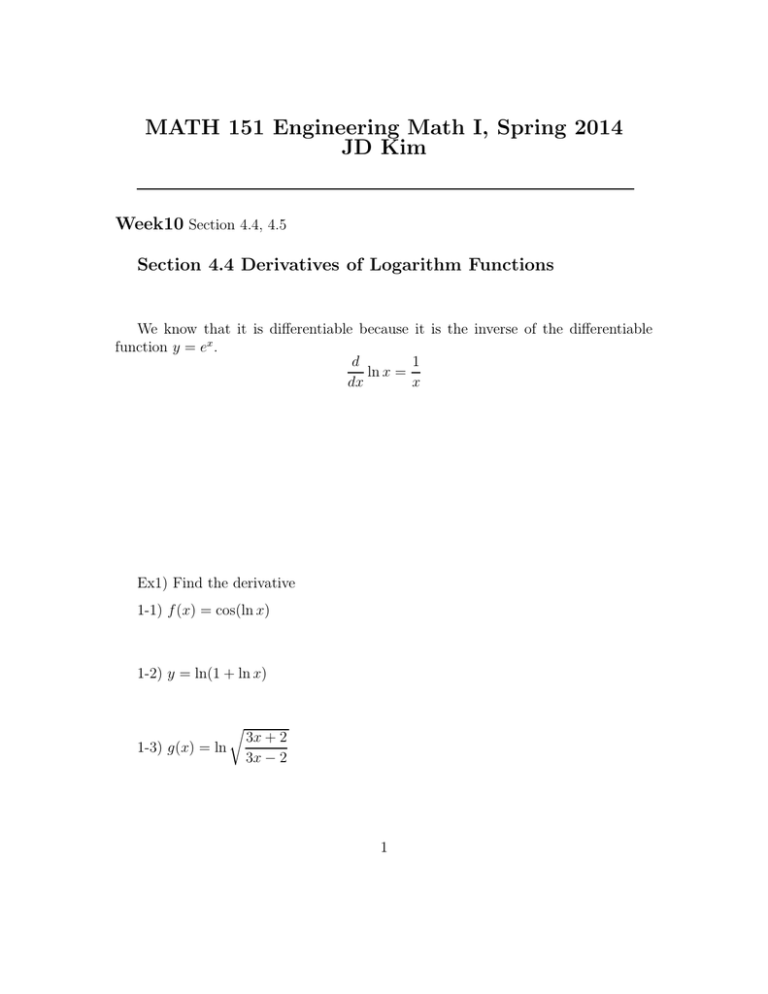
MATH 151 Engineering Math I, Spring 2014 JD Kim Week10 Section 4.4, 4.5 Section 4.4 Derivatives of Logarithm Functions We know that it is differentiable because it is the inverse of the differentiable function y = ex . 1 d ln x = dx x Ex1) Find the derivative 1-1) f (x) = cos(ln x) 1-2) y = ln(1 + ln x) 1-3) g(x) = ln r 3x + 2 3x − 2 1 x+1 1-4) f (x) = ln √ x−2 d 1 loga x = dx x ln a f ′ (x) d loga f (x) = dx f (x) ln a Ex2) d log(2 + sin x) dx 2 d x a = ax ln a dx d f (x) a = af (x) ln a · f ′ (x) dx Ex3) d x2 10 dx Ex4) Find the derivative of f (x) = tan5 x + 5tan x Ex5) Find the derivative of f (x) = log3 (5 − x4 ). 3 Logarithmic Differentiation The calculation of derivatives of complicated functions involving products, quotients, or powers can often be simplified by taking logarithms. Steps in Logarithmic Differentiation 1. Take logarithms of both sides of an equation y = f (x). 2. Differentiate implicitly with respect to x. 3. Solve the resulting equation for y ′. √ x3/4 x2 + 1 Ex6) Differentiate y = (3x + 2)5 Ex7) Differentiate these; 7-1) f (x) = (sin x)cos x 4 7-2) y = ex (x2 + 2)3 (x + 1)4 (x2 + 3)2 5 Section 4.5 Exponential Growth and Decay In many natural phenomena, quantities grow or decay at a rate proportional to their size. Definition If y(t) is the value of quantitiy at time t and if the rate of change of y with respect to t is proportional to its size y(t) at any time, then dy = ky dt where k is a constant. Then the quantity y(t) at time t is given by y(t) = y0 ekt where y0 is the initial quantity and k is a constant. The GOAL is to find k. 6 Ex8) A bacteria culture starts with 1000 bacteria, and after half an hour the population is tripled. a) Find an expression for the number of bacteria after t hours. b) Find the number of bacteria after 20 minutes. 7 Half-Life The half-life of a substance is the amount of time it takes for half of the substance to disintegrate. Ex9) The half-life of radium-226 (226 88 Ra) is 1590 years. a) A sample of radium-226 has a mass of 100 mg. Find a formula for the mass of 226 88 Ra that remains after t years. b) When will the mass be reduced to 30 mg? 8 Ex10) After 3 days a sample of radon-222 decayed to 58% of its original amount. What is the half-life of radon-222? How long will it take the sample to decay to 10% of its original amount? 9 Ex11) A curve passes through the point (0,7) and has the property that the slope of the curve at every point p is half the y-coordinate of p. Find the equation of the curve. 10 Ex12) The rate of change of atmospheric pressure P with respect to altitude h is proportional to P , provided that the temperature is constant. At a specific temperature the pressure is 101 kP a at sea level and 86.9 kP a at h = 1000 m. what is the pressure at an altitude of 3500 m 11 Compound Interest If A0 dollars is invested at r % compounded n times a year, then the amount in r the account after t years is given by A = A0 (1 + )nt . n Ex13) If $4000 is invested at 8 % compounded monthly, how much money is in the account at the end of 6 years? 12 Continuous Compound Interest If P dollars is invested at r % compounded continuously, then the amount in the account after t years is given by A = P ert . Ex14) How much money should be invested now at 6 % compounded continuously in order to have $30, 000 after 18 years from now? 13 Definition The rate of cooling of an object is proportional to the temperature difference between the object and the temperature of the object’s surroundings. If y(t) is the dy = k(y − T ), where y is the temperature temperature of the object at time t, then dt of the object at time t and T is the room temperature (the temperature of the room in which the object is cooling). The solution of this equation, which gives the temperature of the object at time t, is y(t) = (yo − T )ekt + T , where y0 is the initial temperature of the object. Ex15) A thermometer is taken from a room where the temperature is 20◦ C to the outdoors, where the temperature is 5◦ C. After one minute, the temperature reads 12◦ C. Use Newton’s Law of cooling to answer the following questions. a) What will the reading of the thermometer be after 2 minutes? b) When will the thermometer read 6◦ C? 14
